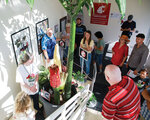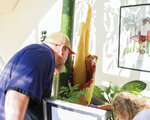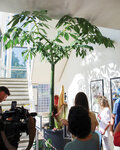



Titan VanCoug, the rare corpse flower housed on the campus of Washington State University Vancouver, bloomed again last week, but this time, the stinky corpse flower could be seen in four stages of life, a spectacle that has never been seen from one flower pot.
After a suspected overwatering accident cloned the corm, or tuber, of the corpse flower, visitors could see the four plants in one pot in different life stages on Friday, June 30. People could see a leaf, fruit from the 2022 bloom and the 2023 bloom.
Titan VanCoug was first planted as a seed from the University of Wisconsin-Madison’s titan arum plant named Big Bucky in 2002. WSU Vancouver professor emeritus Steve Sylvester cultivated Titan VanCoug in a desktop pot until it outgrew its small space.
Titan VanCoug finally bloomed at 17 years old during July of 2019. After Syvester retired as an associate professor of molecular biosciences in 2021, he left instructions on how to take care of the plant. Classroom support technician Dawn Freeman took over the care of Titan VanCoug and under her watchful eye, a second bloom occurred in August of last year.
During a public viewing of the bloom on June 30, Sylvester, Freeman and classroom support technician Mark Owens were there to answer questions and care for the corpse flower.
“It is really rare to have that and super exciting to be able to share that with the world that you know. Titan really put on a show for us,” Freeman said regarding the opportunity to view four separate stages of life.
She added the fourth cycle of the corpse flower’s life was viewable as a new emergence, which showed all the right pointers for a likely bloom.
“And the fact that we’ve got another emergence coming up, too, everybody wanted to join the party this time. Everybody wants to come out to play and it’s the right time of year,” Freeman said. “It has also been dormant for a really long time and hasn’t bloomed yet … so those three indicators kind of make it pretty likely that it is going to be a bloom, so we might be doing this one more time next month.”
Freeman pollinated the corpse flower during the public viewing, by utilizing pollen from other sources.
“I used UC Riverside, UC Santa Cruz and the Chicago Botanic Garden today to pollinate, so basically, we kind of have to act like the fly,” Freeman said.
In the limestone hills of Sumatra, Indonesia’s rainforests, the corpse flower attracts flies as pollinators flock to the stench that Freeman described varying from rotting fish, garlic, or dirty socks.
“We want pollen from somewhere else to increase the genetic diversity of the species. This time, I did a deliberate pollination with three different kinds to take a look at what the politicians’ success rate might be,” Freeman said. “I’m going to share this information with Chicago Botanic Garden because they are spearheading some DNA research on lineages and trying to find who has who and who is least related to who, so when you need to get pollen, you kind of have a better idea of who to go to.”